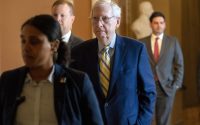The Supreme Court’s student loan forgiveness case, explained
The nation’s top court heard arguments Tuesday on President Biden’s controversial $400 billion student loan write-off program.
Here’s a breakdown of what is at issue — and at stake.
What it’s all about
The legal saga is not over the merits of the sweeping, 30-year proposal, but whether Biden exceeded the limits of his power by trying to enact it without congressional approval.
Six Republican-led states — Arkansas, Iowa, Kansas, Missouri, Nebraska and South Carolina — are at the forefront of the legal battle against the administration.
The White House says it has the power to unilaterally enact the program under the 2003 Higher Education Relief Opportunities for Students (HEROES) Act, claiming the Biden plan amounts to administration of a benefit rather than new legislation.
The administration was forced to use the two-decade-old act for legal support after realizing their plan didn’t have enough votes to get through Congress.
The HEROES act was originally inked after the Sept. 11, 2001 terror attacks to help US service members stay financially afloat while they were off fighting in Afghanistan and Iraq.

The law was eventually broadened to allow the secretary of education to alter the terms of other federal student loans during national emergencies — such as, in the administration’s argument, the COVID-19 pandemic.
Former President Donald Trump declared the outbreak a national emergency in 2020, suspending the collection of federally held student loans. Even though Biden has announced that declaration will expire May 11, the White House is arguing that the economic consequences of the pandemic will linger, making the giveaway program a necessity.
Other issues at play
In addition to determining whether the administration violated the separation of powers, the court must also consider whether the six states and two borrowers challenging the program had the legal right to sue.


Parties generally have to show that they would suffer financial harm in order to have standing to sue in cases such as this. A federal judge initially found that the states would not be harmed and dismissed their lawsuit before an appellate panel said in November the case could proceed.
One of the two borrowers who sued the administration in Texas has student loans that are commercially held, while the other is eligible for $10,000 in debt relief, not the $20,000 maximum. They stand to receive nothing if they win the case.
Biden’s end runs
The student loan forgiveness program is not the first time Biden has tired to cut Congress out of major policy changes.
Shortly after taking office, Biden issued a slew of such executive orders, including one halting construction of a wall along the US-Mexico border and extending the moratorium on evictions and foreclosures during COVID. The administration has also been locked in a legal battle over ending the Title 42 health policy, which allows quick expulsion of migrants suspected of carrying COVID.


Who would qualify
Individual borrowers making fewer than $125,000 annually or households earning fewer than $250,000 a year would be eligible for the break as long as their loans were given out before July 1, 2022.
Pell Grant recipients also could seek the aid if they can prove they are in need of the help.
That’s about 43 million eligible borrowers in all, more than half of whom — 26 million — have already applied for the break. Of that total, 16 million have already been approved for the relief, the White House says.

How much borrowers could get
The debt plan would cancel up to $10,000 in loans for qualifying individuals and households and up to $20,000 for Pell Grant recipients.
What this could cost tax payers
The program carries a mind-boggling price tag of nearly $400 billion over 30 years.
When we’ll know anything
It will likely take at least several months before the case’s outcome is clear. The Supreme Court typically releases its most important decisions just before its term wraps up at the end of June.


